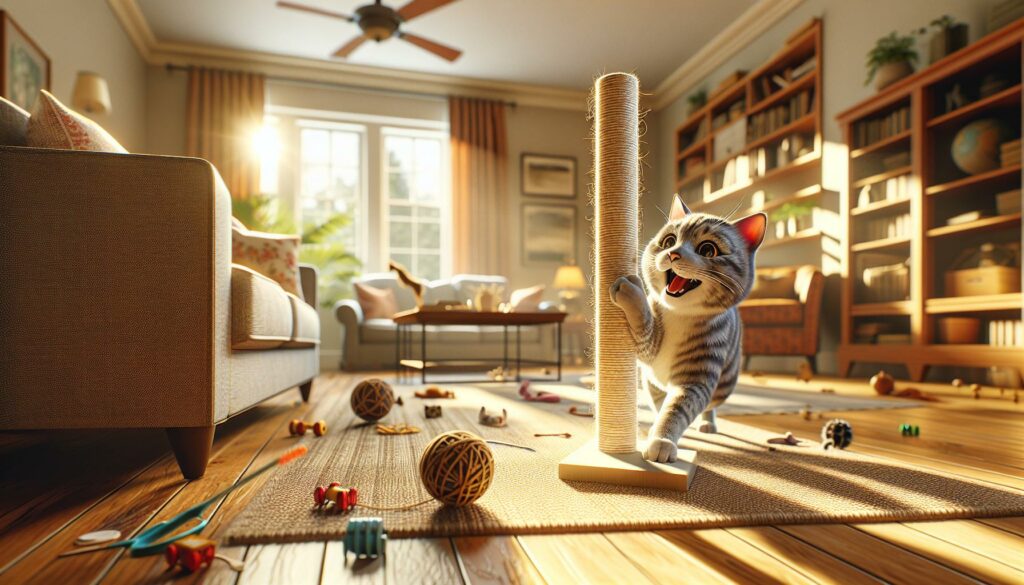If you’re a cat owner, you know the struggle of keeping your furniture scratch-free. Those adorable little paws can wreak havoc on your favorite couch or chair, leaving unsightly marks and frayed fabric. It’s frustrating, but it doesn’t have to be a losing battle. With a few simple home remedies, you can protect your furniture while keeping your feline friend happy.
I’ve discovered effective methods that not only deter scratching but also promote healthier habits for my kitty. By understanding why cats scratch and implementing some practical solutions, you can create a harmonious environment for both you and your pet. Let’s dive into some tried-and-true home remedies that will help you reclaim your furniture without sacrificing your cat’s natural instincts.
How to Stop Cats From Scratching Furniture Home Remedy
- Understand Scratching Behavior: Recognize that scratching is a natural cat behavior for sharpening claws, marking territory, and exercising, which is crucial for developing effective solutions.
- DIY Remedies: Utilize home remedies like bitter sprays (mixing water with white vinegar) and DIY scratch pads made from cardboard and sisal to redirect scratching behavior.
- Create Safe Environments: Modify your home by creating designated safe spaces for your cat, including cat trees and cozy beds, to satisfy their natural instincts and reduce furniture damage.
- Choose Cat-Friendly Furniture: Select durable and scratch-resistant furniture materials, such as microfiber or solid wood, and consider pieces with built-in scratch surfaces.
- Train with Positive Reinforcement: Employ positive reinforcement techniques by rewarding your cat with treats or praise when they use appropriate scratching surfaces to encourage good habits.
- Redirect Scratching Effectively: Provide appealing scratching alternatives near targeted furniture and use catnip to attract your cat to these designated areas, promoting a harmonious home.
Understanding Cat Scratching Behavior
Understanding why cats scratch helps me address the issue effectively. Scratching is a natural behavior for cats, and recognizing its purpose allows for better solutions.
Why Cats Scratch Furniture
Cats scratch furniture for several reasons. First, scratching allows cats to sharpen their claws by removing the outer sheath. Second, scratching serves as a way for cats to mark their territory; they have scent glands in their paws that release pheromones. Finally, scratching provides physical exercise and helps cats stretch their muscles. Recognizing these reasons can help me create a comprehensive approach to discourage inappropriate scratching without disrupting their instinctual behaviors.
The Benefits of Scratching
Scratching offers numerous benefits for cats. It promotes claws’ health by preventing overgrowth and potential injury. Scratching also helps relieve stress and anxiety, offering an outlet for natural instincts. Additionally, it encourages physical activity, contributing to a cat’s overall well-being. Acknowledging the benefits of scratching can assist me in finding alternative solutions that accommodate my cat’s needs while protecting my furniture.
Home Remedies to Stop Cats from Scratching Furniture
Home remedies can effectively deter cats from scratching furniture. Utilizing simple ingredients or tools around the house can create a cat-friendly environment while preserving your belongings.
Bitter Sprays and Deterrents
Bitter sprays are a popular solution for discouraging scratching. These sprays contain unpleasant flavors that deter cats without harming them. Many commercial options exist, but you can also create your own by mixing equal parts water and white vinegar in a spray bottle. Spraying this mixture on furniture and fabric can help keep cats from scratching. Test it on a small area first to ensure it doesn’t damage the material. Reapply weekly for best results.
DIY Scratch Pad Solutions
Creating DIY scratch pads can redirect your cat’s scratching behavior. Use materials like cardboard, sisal rope, or carpet scraps. Simply cut the cardboard into various shapes or wrap sisal rope around a sturdy base. Place these scratch pads near the furniture your cat targets. Sprinkle catnip on the pads to attract their interest. Encouraging your cat to use these alternatives can reduce the likelihood of furniture damage.
Environmental Modifications
I can create an environment that discourages my cat from scratching furniture by making specific modifications at home. These adjustments lead to a more harmonious living space for both my cat and me.
Safe Spaces for Your Cat
I establish safe spaces for my cat by providing designated areas that promote a sense of security. Placing a cozy bed or soft blankets in low-traffic areas encourages my feline to relax and reduce unwanted behavior. Including vertical spaces, like cat trees or shelves, offers opportunities for climbing and exploration. This satisfies their natural instincts while diverting attention from my furniture. I also ensure these spaces are away from disturbances, like loud noises or heavy foot traffic, reinforcing a calm environment.
Choosing Cat-Friendly Furniture
I select cat-friendly furniture to minimize damage. Opting for materials like microfiber or leather provides durability against scratches. Choosing pieces with removable, washable covers makes maintenance easier. Incorporating furniture with a high scratch-resistant rating, such as those made from solid wood or composite materials, adds longevity. I also consider furniture designed with built-in scratching surfaces or cat condos, as these dual-purpose items fulfill my cat’s needs while protecting my home’s aesthetic.
Training Techniques
Training techniques can significantly reduce the likelihood of cats scratching furniture. By applying positive reinforcement and redirecting their behavior, I create a more pleasant living environment for both my cats and myself.
Positive Reinforcement Methods
Positive reinforcement effectively encourages desirable behaviors in cats. I reward my cats with treats, praise, or playtime immediately after they use a scratch pad or designated scratching area. This approach establishes a positive association with the alternatives I provide. Consistency is key; I reinforce this behavior every time it occurs, making it clear that scratching in the right place is preferable. Over time, my cats learn that using their scratch pads is rewarding.
Redirecting Scratching Behavior
Redirecting scratching behavior involves providing appealing alternatives in tempting locations. I place scratch pads or boards near the furniture my cats typically target. These alternatives should mimic surfaces they enjoy scratching, such as cardboard, sisal, or carpet. Additionally, I consider using catnip to entice them to explore these options. By ensuring that my cats experience satisfaction from scratching the designated areas, I can reduce unwanted damage to my furniture while respecting their natural instincts.
A Harmonious Home
Finding a balance between protecting my furniture and respecting my cat’s natural instincts can be challenging. By implementing these home remedies and adjustments, I’ve noticed a significant reduction in scratching behavior. It’s rewarding to see my cat happily using designated scratching areas while my furniture remains safe.
Creating an environment that satisfies my cat’s needs not only preserves my belongings but also promotes their well-being. With a little patience and creativity, I can maintain a harmonious home where both my cat and my furniture thrive.

